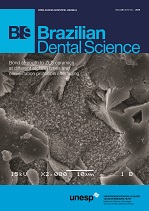Treatment Outcomes Based on Patient’s Oral Health Related Quality of Life (OHRQoL) after Receiving Conventional Clasp or Precision Attachment Removable Partial Dentures in Distal Extension Cases: A Randomized Controlled Clinical Trial
DOI:
https://doi.org/10.14295/bds.2019.v22i4.1819Resumo
Purpose: To compare the effect of two treatment options in mandibular Kennedy class I cases regarding oral health related quality of life (OHRQoL) and the biting force, removable partial dentures retained by either precision attachment (PA-RPD) or clasps (C-RPD)
Materials and methods: The study included 32 partially edentulous patients which 16 patients received PA-RPD (OT Cap Attachment) and 16 patients received C-RPD. All the patients in both groups were asked to fill the OHRQoL questionnaire after 1 week (baseline), 3 months, 6 months and 12 months after prosthesis insertion. Biting force was measured using the i-load Star Sensor one week, 3 months, 6 months and 1 year after partial denture insertion for all patients in both groups. Statistical analysis comprised Mann Whitney U test, Friedman’s test, Dunn’s test and Chi-square test.
Results: The results of OHRQoL revealed that at the baseline, 3 months and 6 months the PA-RPD showed statistically significant lower mean total OHIP-14 score than the C-RPD. However, after 12 Monthes , there was no statistically significant difference between total OHIP-14 scores in the two groups. Concerning the biting force there was no statistically significant difference between the two groups.
Conclusion: Within the limitations of this study it was concluded that the OHRQoL of both the PA-RPD and the C-RPD was comparable after 12 months. Similarly the biting force was the same for both treatment options.
Downloads
Downloads
Publicado
Como Citar
Edição
Seção
Licença
TRANSFERÊNCIA DE DIREITOS AUTORAIS E DECLARAÇÃO DE RESPONSABILIDADE
Toda a propriedade de direitos autorais do artigo "____________________________________________________________________" é transferido do autor(es) para a CIÊNCIA ODONTOLÓGICA BRASILEIRA, no caso do trabalho ser publicado. O artigo não foi publicado em outro lugar e não foi submetido simultaneamente para publicação em outra revista.
Vimos por meio deste, atestar que trabalho é original e não apresenta dados manipulados, fraude ou plágio. Fizemos contribuição científica significativa para o estudo e estamos cientes dos dados apresentados e de acordo com a versão final do artigo. Assumimos total responsabilidade pelos aspectos éticos do estudo.
Este texto deve ser impresso e assinado por todos os autores. A versão digitalizada deverá ser apresentada como arquivo suplementar durante o processo de submissão.




























